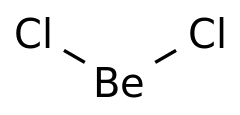HI! I’M ELEMENT AI.
Beryllium Chloride

Product Description
Beryllium chloride is a chemical compound with various industrial applications.
Product:
Beryllium Chloride
CAS:
7787-47-5
Synonym:
Beryllium dichloride
Structure:

Typical Characteristics
Appearance
White or yellow crystals
Boiling point
482 °C
Density
1.899 g/cm3
Melting point
399 °C
Molecular Weight
79.9
Purity
95%
Refractive index
1.553
Uses, Applications & Markets
Key applications
Markets
get a quote
We Offer Beryllium Chloride
in various grades
A few of the grades available are listed below:



Beryllium Chloride used in many
industry applications
Beryllium chloride is a chemical compound with various industrial applications. Here are some of its uses:
- Organic Synthesis: Beryllium chloride is utilized as a catalyst in organic synthesis reactions, particularly in the production of pharmaceuticals, agrochemicals, and fine chemicals.
- Electroplating: It may be used in electroplating baths for the deposition of beryllium coatings onto metal surfaces, providing corrosion resistance and enhancing surface properties.
- Fluorescent Lighting: Beryllium chloride is employed in the production of fluorescent lamps and lighting fixtures as a phosphor binder to enhance light output and color rendering properties.
- Nuclear Reactors: It finds applications in nuclear reactors and nuclear power plants as a neutron moderator and coolant, helping to control and regulate nuclear fission reactions.
- Gas Phase Chlorination: Beryllium chloride is used in gas phase chlorination processes for the production of organic chlorinated compounds, plastics, and polymers.
- Catalyst Manufacturing: It serves as a precursor in the manufacture of various beryllium-containing catalysts used in petrochemical refining, polymerization, and chemical synthesis processes.
- Organometallic Chemistry: Beryllium chloride is employed in organometallic chemistry as a starting material for the synthesis of beryllium-containing organometallic compounds used in research and industrial applications.
- High-Temperature Materials: It may be incorporated into ceramic and glass compositions to improve thermal stability, mechanical strength, and resistance to chemical corrosion at elevated temperatures.